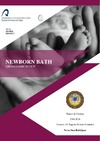Please use this identifier to cite or link to this item:
https://accedacris.ulpgc.es/jspui/handle/10553/41556
| DC Field | Value | Language |
|---|---|---|
| dc.contributor.advisor | Ferrera Fernández, Mª de los Ángeles | es |
| dc.contributor.author | Sosa Rodríguez, Nerea | es |
| dc.date.accessioned | 2018-07-13T09:40:23Z | - |
| dc.date.available | 2018-07-13T09:40:23Z | - |
| dc.date.issued | 2018 | en_US |
| dc.identifier.uri | https://accedacris.ulpgc.es/handle/10553/41556 | - |
| dc.description.abstract | Existe cierta controversia en la realización del baño a los recién nacidos (RN), en las diferentes fases de su madurez, en las unidades de neonatología. Las características de la piel de los recién nacidos difiere según su edad gestacional, motivo por el cual, los cuidados necesarios han de individualizarse. Así, pues, nos basamos en la evidencia mediante una revisión de la literatura científica, para identificar la manera adecuada de realizar el cuidado “baño de los recién nacidos”, teniendo en cuenta las condiciones de un RN pretérmino y de un neonato a término o postérmino. | en_US |
| dc.description.abstract | Objectives: Determine what is the most appropriate way, according to the evidence, to bathe a newborn, determine the most appropriate temperature, identify the most appropriate frequency and recognize which products are the best for bathing a premature newborn and term. Methods: A bibliographic search was carried out in the following databases and current evidence centers: Cochrane.org, Dialnet, Pubmed, for which search strategies and certain keywords were used, also applying to articles a series of inclusion and exclusion criteria, previously established. Results: 18 studies were finally included in this review: of these definitively chosen documents, 7 are systematic reviews, 3 are cohort studies and 2 randomized study, 1 quasi- experimental study, 4 descriptive studies and 1 observational study. Conclusions: There is no consensus on when to do the first bath, on the temperature at which the water should be, or on the use of the sponge during the bath. However, there is agreement with the use of chlorhexidine for the care of the umbilical cord, the use of emollients in premature and term infants with physiological dryness and with the use of soaps with neutral or slightly acidic Ph. On the other hand, the frequency of bathing for a premature and full- term newborn is different. Note that there is little evidence on how to perform the bath in premature newborns and controversies about their clinical practice in the newborn in general, which is why it is advisable to continue deepening this line of research. | en_US |
| dc.language | spa | en_US |
| dc.subject | 3212 Salud pública | en_US |
| dc.subject.other | Baño | es |
| dc.subject.other | Recién nacido | es |
| dc.subject.other | Hospital | es |
| dc.subject.other | Piel | es |
| dc.subject.other | Enfermería | es |
| dc.subject.other | Bathing | es |
| dc.subject.other | Newborn | es |
| dc.subject.other | Skin | es |
| dc.title | Baño al recién nacido. Revisión bibliográfica | es |
| dc.type | info:eu-repo/semantics/bachelorThesis | es |
| dc.type | BachelorThesis | es |
| dc.contributor.departamento | Departamento de Enfermería | es |
| dc.contributor.facultad | Facultad de Ciencias de La Salud | en_US |
| dc.investigacion | Ciencias de la Salud | en_US |
| dc.type2 | Trabajo final de grado | en_US |
| dc.identifier.matricula | TFT-49029 | es |
| dc.identifier.ulpgc | Sí | es |
| dc.contributor.titulacion | Grado en Enfermería | es |
| item.grantfulltext | open | - |
| item.fulltext | Con texto completo | - |
| crisitem.advisor.dept | Departamento de Enfermería | - |
| Appears in Collections: | Trabajo final de grado | |
Page view(s)
5,990
checked on Jun 15, 2024
Download(s)
54,364
checked on Jun 15, 2024
Google ScholarTM
Check
Share
Export metadata
Items in accedaCRIS are protected by copyright, with all rights reserved, unless otherwise indicated.

